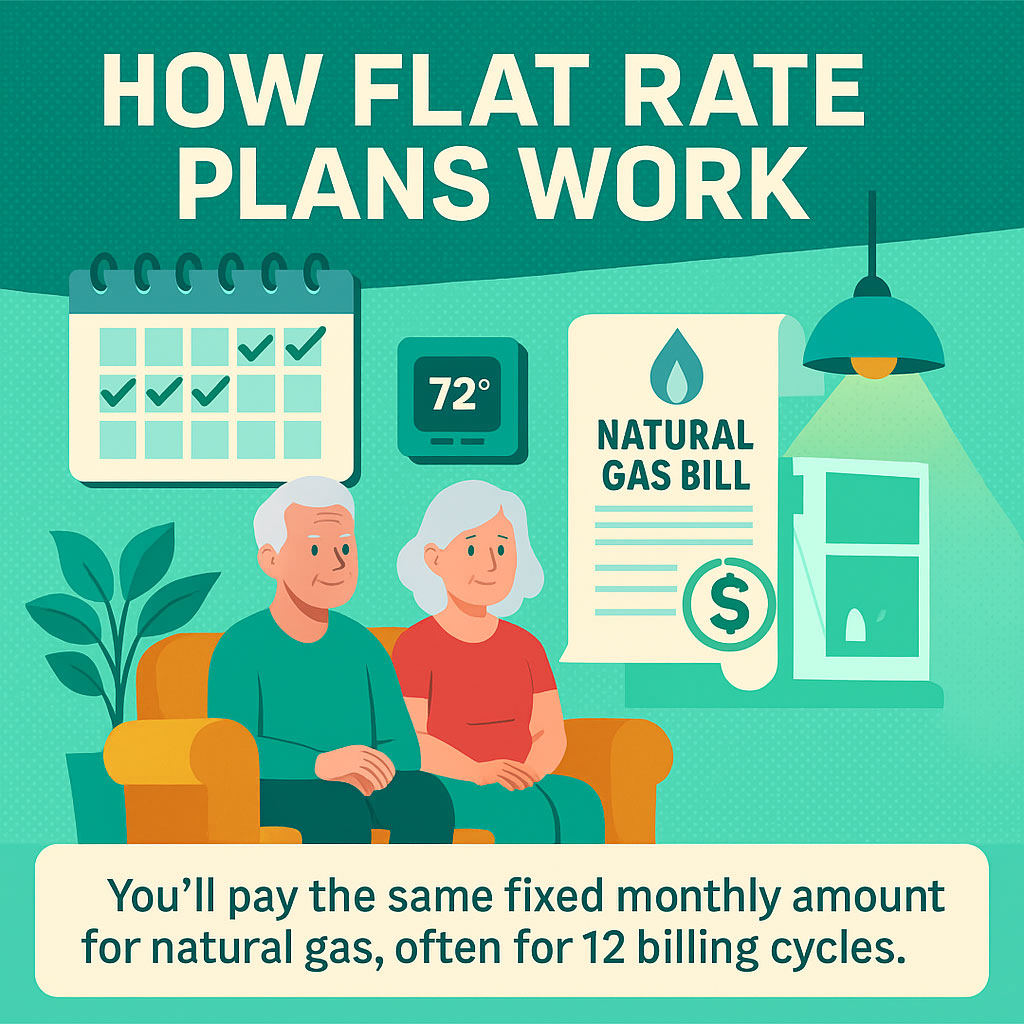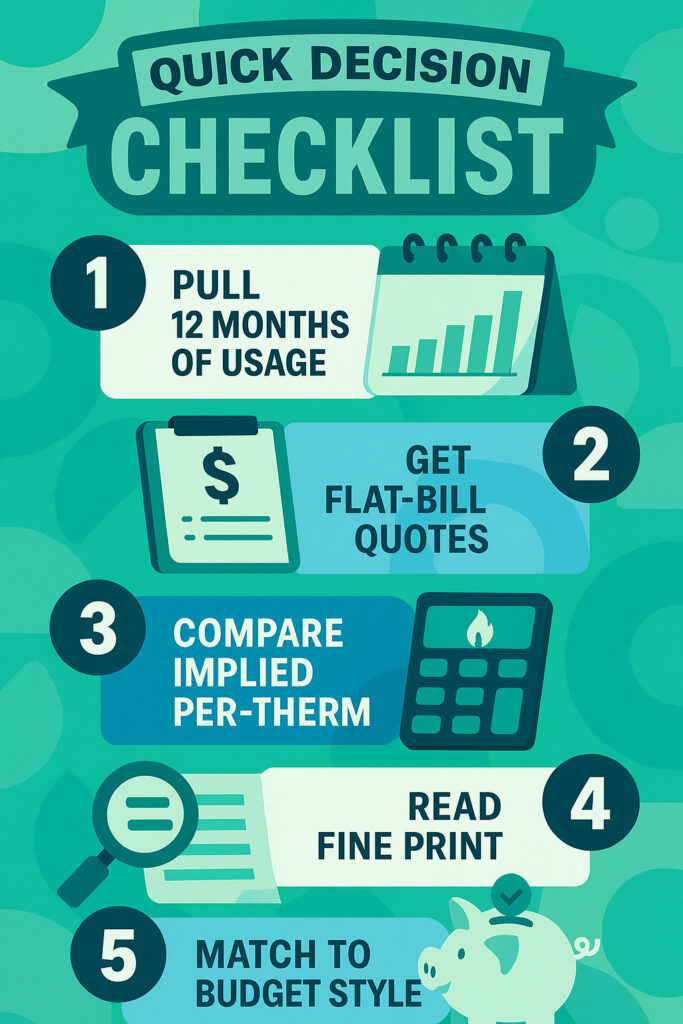Key Takeaways
- You pay the same set amount every month regardless of usage, which makes budgeting easier and avoids seasonal bill spikes.
- Ideal for people who value predictability, have big seasonal swings in usage, or want to avoid tracking rates and usage constantly.
- Compare the true cost by calculating the “implied per-therm” rate from flat-bill offers and compare it to fixed-rate plans to see if the stability is worth the premium.
- Check the fine print for clauses about usage limits, early termination fees, and whether the plan can be transferred if you move.
What a Flat Rate Plan Is (And What They’re Not)
A flat-rate (a.k.a. “flat-bill”) natural gas plan charges you the same dollar amount every month for the length of your contract, regardless of how many therms you actually use. Think of it as a subscription: one price, predictable bills. Providers build that monthly price around your historical usage, home characteristics, local weather, and a buffer for risk.
People often confuse three terms:
- Flat-rate / Flat-bill: One fixed monthly bill (e.g., $99/month), usage doesn’t change the payment.
- Fixed-rate: One fixed price per therm (e.g., $0.79/therm) + standard fees; your monthly bill still rises and falls with usage.
- Budget/levelized billing (utility program): Your payments are averaged over time and periodically trued-up so you pay exactly what you used across the year, not a guaranteed flat subscription.
How Flat Rate Plans Work

Providers estimate what it will cost to supply your gas for a year, add risk and margin, and turn that into a set monthly price for a 6–24 month term (12 months is common). You pay that same amount each month. Most plans do not true-up, you’re buying the predictability, not just the energy.
What typically goes into the flat price
- Your expected annual usage (past bills, home size, insulation, appliances).
- Weather normalization for typical winters in your area.
- Market costs & risk premium (providers hedge against price spikes).
- Contract specifics (term length, early termination fees, autopay discounts, etc.).
Check the Fine Print
- Usage thresholds or “extraordinary use” clauses (rare but possible).
- Provider’s right to adjust or cancel after extreme consumption or market shocks.
- Move policy (can you transfer the plan if you relocate within the service area?).
- Early termination fee (ETF) if you switch before the term ends.
Flat-Rate vs Fixed-Rate vs Variable-Rate
Choosing a natural gas plan comes down to what you value most: predictable bills, price stability per unit, or month-to-month flexibility. The table below breaks down fixed-rate, variable-rate, and flat-rate (flat-bill) plans so you can see, at a glance, how each one charges you, how much your bill can swing with the weather, and the kinds of tradeoffs you’re making on risk and cost. It’s a quick way to match the plan type to your budget style and tolerance for surprises.
As you compare, remember that the supplier’s charge is only part of your bill, utility delivery fees and taxes still apply no matter which plan you choose. For the most apples-to-apples view, grab 12 months of usage and, for any flat-bill offers, calculate the implied per-therm price (annual flat cost ÷ annual therms). Then use the table to weigh predictability vs. potential savings and pick the plan that best fits how you like to budget.
| Plan type | What you pay | Bill swings with weather/usage? | Price risk | Great for | Watch-outs |
|---|---|---|---|---|---|
| Flat-rate (flat-bill) | Same cost per month every month | No, bill is steady | Provider bears market risk; you pay a premium for certainty | Budgeters, set-income households, landlords with fixed budgets | Clauses on “excessive” use, higher cost if you’re a consistently low user |
| Fixed-rate (per therm) | price/therm stays fixed; fees standard | Yes, cold months cost more | Low to moderate (hedged) | Most households wanting price stability without premiums | Still volatile month-to-month due to usage; watch base fees |
| Variable-rate | price/therm changes monthly with market | Yes, and rates can jump | High | Short-term stays, savvy shoppers who monitor markets | Surprise spikes; not great for tight budgets |
Bottom line: Flat-rate buys predictability; fixed-rate buys price stability per unit; variable buys flexibility (and risk).
Tips For Choosing a Plan
Before You Shop
- Know your usage. Grab 12 months of bills (or ask your utility). Annual therms are gold for comparisons.
- Calculate the “implied per-therm” price.
Example: $99/month × 12 = $1,188 per year. If you typically use 600 therms/year, the implied energy price is $1,188 ÷ 600 = $1.98/therm (excluding utility delivery charges). Compare that to a fixed-rate offer. - Separate supply vs. delivery. Your local utility’s delivery fees, taxes, and base charges usually remain no matter which supplier you pick.
What to Ask the Provider
- Is there any true-up? (Most flat-bill plans: no.)
- Any usage caps, seasonal limits, or “extraordinary use” language? If yes, what triggers it?
- Can you change the flat amount mid-term? Under what circumstances?
- Early termination fee and move policy (especially important for renters).
- Payment requirements (autopay, paperless billing, deposits).
- Extras (rewards, smart-thermostat promos, home services, carbon/renewable gas add-ons).
Smart Comparison Moves
- Line up two or three flat-bill quotes and compute each one’s implied per-therm vs. a couple of fixed-rate quotes.
- Consider your risk preference: would a $20–$30/month predictability premium feel worth it in a cold snap?
- Match the term to your plans (moving soon? a shorter term or fixed-rate might fit better).
- Check reviews and state complaints dashboards for the provider’s billing practices and service.
Who are Flat Rate Plans Good For?

- Households that value certainty over chasing the lowest possible rate. If your budget is tight or steady, predictability is often worth a small premium.
- Homes with big seasonal swings (cold winters) where bill spikes are stressful.
- Landlords or shared households splitting a consistent bill, or those needing easier expense planning.
- People who don’t want to track usage or shop rates every season.
Who Might Skip a Flat Rate Plan
- Very low-usage customers (you may overpay vs. a fixed-rate per therm).
- Frequent movers or short-term renters (ETF risk).
- Deal-seekers willing to watch markets and adjust plans.
Pros and Cons of Fixed Rate Plans
Pros
- Rock-solid predictability: Same bill every month, no surprises.
- Stress-free winters: Weather doesn’t swing your payment.
- Simple budgeting: Great for fixed incomes, roommates, or landlords.
- Time saved: Less need to monitor markets or tweak thermostats to avoid bill shock.
Cons
- Premium for certainty: Often costs more than fixed-rate when averaged over a mild year.
- Fine-print risk: Some plans include clauses for “extraordinary usage” or provider adjustments.
- Not ideal for low users: If you use far less than estimated, you don’t pocket the “savings.”
- ETF and move policy gotchas: Early exits can get expensive.
Final Analysis

If you’re the kind of shopper who values peace of mind over micromanaging energy costs, a flat-rate plan can be a great fit. You’ll likely pay a modest premium compared with the “perfect” fixed-rate outcome in an average year, but you’ll also avoid the worst-case spikes in a harsh winter. That tradeoff is the whole point.
Quick Decision Checklist
- Pull 12 months of usage (or a solid estimate).
- Get at least two flat-bill quotes and two fixed-rate quotes.
- Compute the implied per-therm for each flat-bill offer and compare.
- Read the terms: true-up policy, usage clauses, ETF, move rules.
- Pick the plan that matches your budget style: predictability (flat-bill) vs. per-unit value (fixed).
Rule of thumb: If bill stability will reduce stress or help you stay on budget, a flat-rate plan is worth serious consideration. If you’re a low user, moving soon, or like to optimize, a fixed-rate plan will usually deliver better value, while a variable rate only makes sense if you accept volatility and keep a close eye on it.
FAQs About Flat Rate Plans
What is a flat-rate (flat-bill) plan?
How is it different from fixed-rate and budget/levelized billing?
– Fixed-rate: Same cost/therm; your bill still swings with usage.
– Budget/levelized billing: Utility averages payments and trues up periodically so you ultimately pay exactly for what you used.
Do delivery charges and taxes still apply?
How do providers set the flat monthly price?
Is there a year-end “true-up” with flat-rate plans?
What if I use a lot more gas than expected?
How do I compare a flat-rate offer to a fixed-rate offer?
(monthly flat price × 12) ÷ your annual therms.
Compare that figure to fixed-rate ¢/therm offers (remembering utility delivery charges apply in both cases).
Who is a flat-rate plan good for?
Who might not benefit from a flat-rate plan?
What happens if I move?
Do I need a credit check or deposit?
Are there renewable or carbon-offset options with flat-rate plans?
What documents help me get the best quote?
About the Author
David has been an integral part of some of the biggest utility sites on the internet, including InMyArea.com, HighSpeedInternet.com, BroadbandNow.com, and U.S. News. He brings over 15 years of experience writing about, compiling and analyzing utility data.
